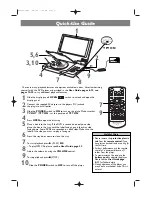
18
Setting the speaker delay time
— CNTR DL (center speaker delay),
SURR DL (surround speakers delay)
You can set the speaker delay time easily by using Smart Surround
Setup (see page 15) or Quick Setup (see page 16).
The distance from your listening point to the speakers is one of the
important element to obtain the best possible surround sound for the
Surround modes.
You need to set the delay time of the center and surround speakers
relative to the front speakers so that sounds through all the speakers
can reach you at the same time.
• 1 msec increase (or decrease) in delay time corresponds to 1 foot
(30 cm) increase (or decrease) in distance.
CNTR DL*:
Set the delay time for the center speaker within a
range of 0 msec to 5 msec (in 1 msec intervals).
SURR DL*:
Set the delay time for the surround speakers within a
range of 0 msec to 15 msec (in 1 msec intervals).
*
“0ms” is the initial setting.
Example: In this case,
set “CNTR DL” to “1ms” and
set “SURR DL” to “2ms.”
NOTE
If the center and/or surround speakers are not connected (see pages
16 and 17), you cannot set the speaker delay time for the center and/
or surround speakers.
Setting the crossover frequency—CROSS
Small speakers cannot reproduce the bass sounds efficiently. If you
use a small speaker in any position, this receiver automatically
reallocates the bass sound elements assigned to the small speaker to
the large speakers.
To use this function properly, set this crossover frequency level
according to the size of the small speaker connected.
• If you have selected “LRG (large)” for all speakers (see page 17),
this function will not take effect.
80HZ:
Select when the cone speaker unit built in the speaker
is about 4
3
/
4
inches (12 cm).
100HZ:
Select when the cone speaker unit built in the speaker
is about 3
15
/
16
inches (10 cm).
120HZ:
Select when the cone speaker unit built in the speaker
is about 3
3
/
16
inches (8 cm).
150HZ*:
Select when the cone speaker unit built in the speaker
is about 2
3
/
8
inches (6 cm).
200HZ:
Select when the cone speaker unit built in the speaker
is less than 2 inches (5 cm).
*
Initial setting
NOTE
Crossover frequency is not valid for the HEADPHONE mode.
Setting the low frequency effect attenuator
—LFE
If the bass sound is distorted while playing back software encoded
with
Dolby Digital
or
DTS
, set the LFE level to eliminate distortion.
• This function takes effect only when the LFE signals come in.
0dB*:
Normally select this.
–10dB:
Select when the bass sound is distorted.
*
Initial setting
Setting the dynamic range compression
—D.COMP
You can compress the dynamic range (difference between maximum
sound and minimum sound) of the reproduced sound. This is useful
when listening to surround sound at night.
• This function takes effect only when playing back a source encoded
with
Dolby Digital
.
OFF:
Select when you want to enjoy surround with its full
dynamic range. (No effect applied.)
MID*:
Select when you want to reduce the dynamic range a
little.
MAX:
Select when you want to apply the compression effect
fully. (Useful at night.)
*
Initial setting
Speaker settings
Left front
speaker
Right front
speaker
Right surround
speaker
Center speaker
Left surround
speaker
9 feet
(2.7 m)
10 feet
(3.0 m)
8 feet
(2.4 m)
7 feet
(2.1 m)
15-20RX-ES1SL[UJ]f
03.5.21, 11:50
18
















































